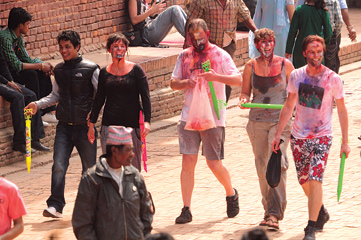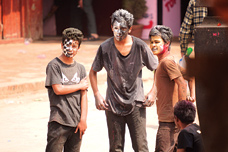Mythology and folklore aside, Holi is a time to forget old rivalries and enjoy the onset of spring and harvest season.
The best way to describe Holi would be to smear this sheet with big splashes of different colors and randomly carve in stick figures, indistinguishable from one another except in shape and size. This ‘festival of colors’ is one of the most important ones for Hindus. Although there is religious significance and mythological reference to Holi, it is essentially a time for merry-making, singing, dancing, cheerful banter, celebration of the coming of spring and the harvest season. It falls on the full moon day in early March (Falgun – Nepali calendar month) so is often referred to locally as Fagu Purnima or just Fagu.
 Many legends and myths surround Holi. Colors and frolicking are just part of it and mark the last day of a week-long celebration in Nepal. Especially in Kathmandu, a long bamboo pole called the “chir” is erected in Basantapur and laden with colorful strips of cloth as good luck charms. This is related to the legend of how Lord Krishna being his amorous and mischievous self teasingly hid the gopinis’ (female cow herders) clothes while they took a dip in the holy Yamuna and hung them on a tall tree.
Many legends and myths surround Holi. Colors and frolicking are just part of it and mark the last day of a week-long celebration in Nepal. Especially in Kathmandu, a long bamboo pole called the “chir” is erected in Basantapur and laden with colorful strips of cloth as good luck charms. This is related to the legend of how Lord Krishna being his amorous and mischievous self teasingly hid the gopinis’ (female cow herders) clothes while they took a dip in the holy Yamuna and hung them on a tall tree.
The legend behind this festival, gives leeway to tease and flirt amongst the young. In India, in parts of the Nepali Terai and even in cities bhang, a cheap intoxicant used recreationally for centuries during Shiva Ratri made from the cannabis plant is gaining popularity. It has now become synonymous with Holi celebrations and is available at local sweetshops. At the onset of the festival, teenagers and even adults throws water balloons at passers-by.
 Another piece of folklore that marks how Holi gets its name is the widely known story of Holika, the sister of the demonic king Hiranyakashap. The king was granted a boon by Lord Brahma for his devotion that made it impossible to kill him. Riding high on this glory, the demon king wanted everyone in his kingdom to worship him as god. While everyone consented, his own son Prahlad became an ardent devotee of Lord Vishnu. Enraged by this apparently blasphemous behavior, the king made many attempts to kill his son. Holika, on the other hand had a special gift of being immune to fire. In an attempt to help her brother, the king kill his son, she sat on a huge fire with Prahlad on her lap. At this, Prahlad chanted Lord Vishnu’s name continuously and in effect, Holika burnt to death whereas Prahlad walked out unscathed. Since Holika had misused the power bestowed on her, she was punished. This is the lesson children are taught over the bonfire lit every Holi’s evening to mark the triumph of good over evil.
Another piece of folklore that marks how Holi gets its name is the widely known story of Holika, the sister of the demonic king Hiranyakashap. The king was granted a boon by Lord Brahma for his devotion that made it impossible to kill him. Riding high on this glory, the demon king wanted everyone in his kingdom to worship him as god. While everyone consented, his own son Prahlad became an ardent devotee of Lord Vishnu. Enraged by this apparently blasphemous behavior, the king made many attempts to kill his son. Holika, on the other hand had a special gift of being immune to fire. In an attempt to help her brother, the king kill his son, she sat on a huge fire with Prahlad on her lap. At this, Prahlad chanted Lord Vishnu’s name continuously and in effect, Holika burnt to death whereas Prahlad walked out unscathed. Since Holika had misused the power bestowed on her, she was punished. This is the lesson children are taught over the bonfire lit every Holi’s evening to mark the triumph of good over evil.
 Sans the myths and the religious history, today Holi is mostly about wearing ragged clothes, coloring your faces, enjoying a little bhang with pakoras (vegetable tempuras), loud music, crazy dancing, forgetting old rivalries and reveling in a lot of colorful play – a reason to celebrate life in its myriad colors.
Sans the myths and the religious history, today Holi is mostly about wearing ragged clothes, coloring your faces, enjoying a little bhang with pakoras (vegetable tempuras), loud music, crazy dancing, forgetting old rivalries and reveling in a lot of colorful play – a reason to celebrate life in its myriad colors.










